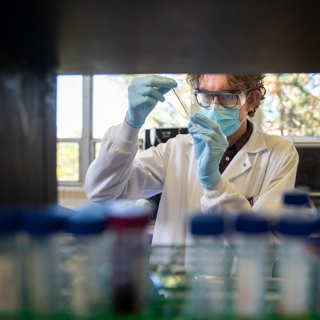People
Jay Evans
Research Professor, Director of CTM
Contact
- Office
- 1121 East Broadway Street, Suite 121
- Phone
- 406 381-0573
- jay.evans@umontana.edu
- Curriculum Vitae
- View/Download CV
Personal Summary
Jay Evans is a Research Professor in the Division of Biological Sciences and Director of the Center for Translational Medicine at the University of Montana. Prior to joining the DBS Faculty at the University of Montana, Dr. Evans worked in the biotechnology and pharmaceutical industry for 15 years at GlaxoSmithKline Vaccines (formerly Corixa Corporation) where he held various positions including Senior Scientist, Investigator and Project Leader. While at GSK Vaccines, Dr. Evans worked on the discovery and development of novel vaccines, adjuvants and immunotherapeutics. Dr. Evans completed is Postdoctoral Fellowship at the University of Texas Southwestern Medical Center and St. Jude Children’s Research Hospital working HIV immunology, stem cell transplantation and lentiviral-based gene therapy systems. Dr. Evans holds a Ph.D. in Molecular and Cellular Biology from Oregon State University and a B.S. in biology from Pacific Lutheran University.
Dr. Evans is also the President and CEO of Inimmune, a biotech company in Missoula, MT focused on the discovery and development of new immunomodulatory therapeutics for treatment of allergic diseases, upper respiratory tract infection, topical treatment of skin diseases and other diseases targeted through innate immune receptor activation or inhibition.
Education
B.S. in Biology, Pacific Lutheran University (Tacoma, WA), 1992
Ph.D. in Molecular and Cellular Biology, Oregon State University (Corvallis, OR), 1998
Research Interests
My laboratory is primarily focused on understanding the molecular mechanisms of host-pathogen interactions and the downstream effects on immunopathology or immune mediated protection. More specifically, we study invariant Pathogen Associated Molecular Patterns (PAMPs) and their associated innate Pattern Recognition Receptors (PRR). Bacteria, viruses and fungi produce invariant molecular patterns or signatures (PAMPs) in the form of proteins, carbohydrates or RNA which is recognized by one or more families of innate immune receptors or PRRs. Binding and activation or inhibition of PRRs by their cognate ligands following infection or vaccination is the first step towards driving subsequent immune mediated protection or immunopathology. In my laboratory we study the structure-activity-relationships of these PRR ligands and the downstream events following receptor activation or inhibition. Understanding the molecular mechanisms of activation and resulting immune system activation allows us to design novel vaccines, adjuvants and immunotherapeutic treatments for infectious diseases, allergy, autoimmunity and cancer. My laboratory works closely with other investigators in the Center for Translational Medicine and pharmaceutical industry to develop promising candidate vaccines and immunotherapeutics from discovery through early clinical development.
Projects
1. C-Type Lectin Receptor Adjuvant Discovery, NIH IIRAD Contract (Evans, PI), 2014-2019
Globally, there are still a number of pathogens that cause a significant burden of disease for which limited to no prophylaxis is available. Among these diseases, many fall into a class of bacterial and fungal pathogens where Th17 mediated immunity has been implicated in disease protection including Mycobacterium tuberculosis (Mtb), Staphylococcus aureus, Pseudomonas aeruginosa, Streptococcus pneumonia, Candida albicans, Aspergillus fumigatus and others. While antigens are available for some of these pathogens, the development of Th17 inducing adjuvants has lagged. This project is focused on the identification and characterization of a new class of Th17-inducing adjuvants based on C-Type Lectin Receptor (CLR) ligands for targeting diseases of significant medical burden where no effective vaccine is available.
2. Nucleolipid Adjuvant Discovery, NIH Contract, (Evans, PI) 2009-2017
This adjuvant discovery approach is focused on the identification and lead optimization of a novel series of Toll Like Recepotor 7/8 agonist molecules, either alone or in synergistic combination with other TLR agonist compounds to enhance innate and adaptive immune responses in rapid-acting vaccines against NIAID category A-C viral agents. We will use the murine influenza vaccine and challenge model with an emphasis on (1) mucosal route of administration, (2) depot-based TLR7/8 nucleolipid formulations, and (3) TLR7/8-TLR4 agonist combinations containing TRIF-selective AGPs. The underlying goal of the project is to develop new, safe and effective vaccine adjuvants or adjuvant combinations that elicit protective immune responses in animal models when co-administered with a cognate antigen.
3. Host-Pathogen interactions and the equilibrium between immune protection, tissue inflammation and immunopathology
The equilibrium between immune protection and tissue inflammation mediated by both innate and adaptive immune mediators will define the outcome of infections in both naïve and vaccine-primed individuals. In the case of influenza virus, RSV, dengue virus and others both pre-clinical and clinical studies have demonstrated a need for a more thorough characterization of immune responses following both vaccination or natural infection, particularly when novel adjuvants, antigens or formulations are used for vaccination. We seek to understand the innate and adaptive mechanisms associated with tissue inflammation and increased morbidity/mortality versus immune mediated protection in naïve or immune-primed individuals. A better understanding of these molecular mechanisms of host defense will aid in the design and development of safer and more effective vaccines or immunotherapeutics.
Publications
H. Oberoia, Y.M. Yorgensen, A. Morasse, J.T. Evans, D.J. Burkhart. 2015. PEG modified liposomes containing CRX-601 adjuvant in combination with methyl glycol chitosan enhance the murine sublingual immune response to influenza vaccination. J Control Release. 2016 10;223:64-74
J. Spinner, H. Oberoi, D. Burkhart, J. Evans. 2015. Methylglycol chitosan and CRX-601 enhance the murine immune response to influenza vaccine administered sublingually. Vaccine 33:5845–5853
H. G. Bazin, Y. Li, J.K. Khalaf, S. Mwakwari, M.T. Livesay, J.T. Evans, D.A. Johnson. 2015. Structural requirements for TLR7-selective signaling by 9-(4-piperidinylalkyl)-8-oxoadenine derivatives. Bioorganic & Medicinal Chemistry Letters 25 1318–1323
J.K. Khalaf, W.S. Bowen, H.G. Bazin, K.T. Ryter, M.T. Livesay, J.R. Ward, J.T. Evans, D.A. Johnson. 2015. Characterization of TRIF Selectivity in the AGP Class of Lipid A Mimetics: Role of Secondary Lipid Chains. Bioorg Med Chem Lett. Feb 1;25(3):547-53.
A. Maroof, Y.M. Yorgensen, Y. Li , J.T. Evans. 2014 Intranasal vaccination promotes detrimental Th17-mediated immunity against influenza infection. PLoS Pathogens. Jan;10(1).
W. S. Bowen, L. Minns, D.A. Johnson, T.C. Mitchell, M.M. Hutton, J.T. Evans. 2012 Selective TRIF-Dependent Signaling by a Synthetic TLR4 Agonist. Science Signaling, February 14, 5(211).
H.G. Bazin, T.J. Murray, W.S. Bowen, A. Mozaffarian, S.P. Fling, L.S. Bess, M.T. Livesay, J.S. Arnold, C.L. Johnson, K.T. Ryter, C.W. Cluff, J.T. Evans, and D.A. Johnson. 2008 The ‘Ethereal’ Nature of TLR4 Agonism and Antagonism in the AGP Class of Lipid A Mimetics. Bioorganic & Medicinal Chemistry Letters. 18: 5350–5354.
D.H. Persing, P. McGowan, J.T. Evans, C. Cluff, S. Mossman, D. Johnson, J.R. Baldridge. 2006 Imunopotentiators in Modern Vaccines. Chapter 6. Elsevier Academic Press.
B.S. Thompson, P.M. Chilton, J.R. Ward, J.T. Evans, and T.C. Mitchell. 2005. The low toxicity versions of LPS, MPL®adjuvant and RC529, are efficient adjuvants for CD4+ T cells. Journal of Leukocyte Biology 78 (10):
C.W. Cluff, J.R. Baldridge, A.G. Stover, J.T. Evans, D.A. Johnson, M.J. Lacy, V.G. Clawson, V.M. Yorgenson, C.L. Johnson, M.T. Livasay, R.M. Hershberg, and D.H. Persing. 2005. Synthetic toll-like receptor 4 agonists stimulate innate resistance to infectious challenge. Infect. Immun. 73(5): 3044-52.
J.R. Baldridge, P. McGowan, J.T. Evans, C.W. Cluff, S. Mossman, D.A. Johnson and D.H. Persing. 2004. Taking a Toll on Human Disease: TLR4 Agonists as Vaccine Adjuvants and Monotherapeutic Agents Expert Opin Biol Ther. 4(7):1129-38
J.T. Evans, J.R. Ward, J. Kern, and M. Johnson. 2004. A single vaccination with protein-microspheres elicits a strong CD8 T-cell mediated immune response against Mycobacterium tuberculosis antigen Mtb8.4. Vaccine, 22: 1964-1972
A.G. Stöver, J.D.S. Correia, C.W. Cluff, J.T. Evans, M.W. Elliott, E.W. Jeffery, D.A. Johnson, M.J. Lacy, J.R. Baldridge, P. Probst, R.J. Ulevitch, D.H. Persing, and R.M. Hershberg. 2004. Structure-activity relationship of synthetic toll-like receptor 4 agonists. J. Biol. Chem. 279(6): 4440-4449
J.T. Evans, C.W. Cluff, D.A. Johnson, M.J. Lacy, D.H. Persing and J.R. Baldridge. 2003. Enhancement of antigen-specific immunity via the TLR4 ligands MPLTM adjuvant and Ribi.529. Expert Review of Vaccines 2(2): 219-229.
J.R. Baldridge, C.W. Cluff, J.T. Evans, M.J. Lacy, J.R. Stephens, V.G. Brookshire, R. Wang, J.R. Ward, Y.M. Yorgensen, D.H. Persing, D.A. Johnson. 2002. Immunostimulatory activity of aminoalkyl glucosaminide 4-phosphates (AGPs): induction of protective innate immune responses by RC-524 and RC-529. J. Endo. Res. 8(6):453-458
J.T. Evans, P. Cravens, J. Gatlin, P.F. Kelly, P.E. Lipsky, and J.V. Garcia. 2001. Pre-clinical evaluation of an in vitro selection protocol for the enrichment of transduced CD34+ cell-derived human dendritic cells. Gene Therapy 8:1427-1435.
J.T. Evans, P. Cravens, P.E. Lipsky and J.V. Garcia. 2000. Differentiation and expansion of lentivirus-vector marked dendritic cells from bone marrow, mobilized peripheral blood and cord blood CD34+ cells. Human Gene Therapy 11:2483-2492.
J.T. Evans and J.V. Garcia. 2000. Lentivirus vector mobilization and spread by Human Immunodeficiency Virus. Human Gene Therapy 11:2331-2339.
J.T. Evans, Y. Okamoto, D.C. Douek, R.D. McFarland, J. Gatlin, R.A. Koup and J.V. Garcia. 2000. Thymocyte differentiation from lentivirus-marked CD34+ cells in infant and adult human thymus. J. Immunol. Methods 245:31-43
J. Gatlin, J.L. Douglas, J.T. Evans, J.V. Garcia. 2000. In vitro selection of lentivirus transduced human CD34+ cells. Human Gene Therapy 11: 1949-1957
J.T. Evans, P.F. Kelly, J.L. Douglas, E. O’Neill, and J.V. Garcia. 1999. Human cord blood CD34+/CD38- cell transduction via lentiviral-based gene transfer vectors. Human Gene Therapy 10:1479-1489.
J.L. Douglas, P.F. Kelly, J.T. Evans, J.V. Garcia. 1999. Efficient transduction of human lymphocytes and CD34+ cells via HIV-based gene transfer vectors. Human Gene Therapy 10:935-945.
J. Kuzio, M.N. Pearson, S.H. Harwood, C.J. Funk, J.T. Evans, J.M. Slavicek, and G.F. Rohrmann. 1999. Sequence and analysis of the genome of a baculovirus pathogenic for Lymantria dispar. Virology 253:17-34.
J.T. Evans, G.S. Rosenblatt, D.J. Leisy and G.F. Rohrmann. 1999. Characterization of the interaction between the baculovirus ssDNA-binding protein (LEF-3) and helicase (P143). J. Gen. Virol. 80:493-500.
J.T. Evans and G.F. Rohrmann. 1997. The baculovirus single-stranded DNA binding protein, LEF-3, forms a homotrimer in solution. J. Virol. 71:3574-3579.
J.T. Evans, D.J. Leisy and G.F. Rohrmann. 1997. Characterization of the interaction between the baculovirus replication factors, LEF-1 and LEF-2. J. Virol. 71:3114-3119.
C. Ahrens, R. Russell, C.J. Funk, S. Harwood, J.T. Evans and G.F. Rohrmann. 1997. The sequence of Orgyia pseudotsugata multinucleocapsid nuclear polyhedrosis virus genome. Virology. 229:381-399.
US Patents/Applications:
Method for Inducing a Trif-Bias. US Patent #8,629,116
Immunostimulant compositions comprising aminoalkyl glucosaminide phosphates and saponins. US Patent Application #20030190333
Compositions and methods for delivery of proteins and adjuvants encapsulated in microspheres US Patent Application #20030108565, 20070148254
Liposomal compositions for mucosal delivery. US Patent Application VR65672WO
Novel adjuvant formulations and methods for the preparation thereof. Solid lipid nanoparticles (SLNs), wherein the SLNs comprise an aminoalkyl glucosaminide phosphate (AGP). US Patent Application VR66020P
Professional Experience
Research Professor, University of Montana (Missoula, MT) 2016-current
Presedent and CEO, Inimmune Corp (Missoula, MT) 2016-current
Investigator, GlaxoSmithKline Vaccines (Hamilton, MT) 2006-2015
Scientist, Project Leader, Corixa Corporation (Hamilton, MT), 2000-2005
Postdoctoral Fellow, University of Texas, Southwestern Medical Center (Dallas, TX), 1999-2000
Postdoctoral Fellow, St. Jude Childrens Research Hospital, (Memphis, TN), 1998-1999
Laboratory Internship, Weyerhauser Technology Center (Federal Way, WA), 1991-1992

